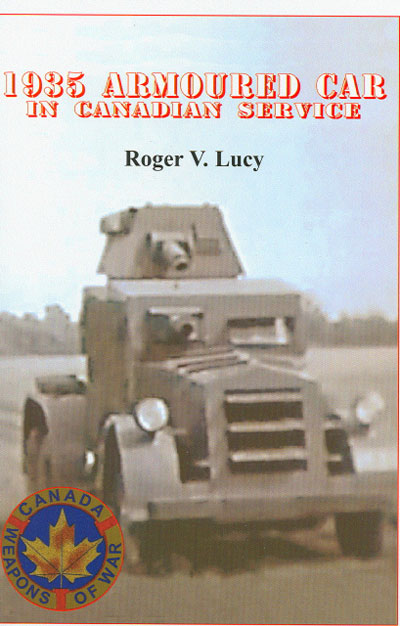| |
1935 Armoured Car in Canadian Service
by Roger V. Lucy

"Weapons of War" Series; Service Publications, Ottawa, Ontario,
Canada, 2005; 24 pp. with B&W photos and one painting diagram; price
CDN $9.95; ISBN 1-894581-28-8 (http://www.servicepub.com)
Advantages: truly obscure subject, but presented in an interesting way
and in historical perspective
Disadvantages: may be too obscure for some modelers or armor history buffs
Rating: Highly Recommended
Recommendation: for all Canadian armour fans and armor fans in general
Everybody has to start somewhere - that's somewhat fatuous, but a true
statement when you consider how technology became inculcated in modern
societies. This little book from Canada, part of the continuing and excellent
series from Service Publications, covers a truly obscure armored vehicle
which appears to have been the seminal armored vehicle produced in Canada.
During the 1930s, the USA, UK, and Germany were dabbling with new armored
vehicle designs, the French were determining the direction in which they
wanted to move, and only the USSR was plowing away full steam on developing
and building armored vehicles. Canada too decided to dip its toe into
the waters of modern armored combat, and the option they chose was the
creation of a heavy armored car. It must be noted that it was proposed
in 1927, but it was 1932 before any action was taken on that proposal.
Mechanization had begun in 1929, and the natural place to turn was to
Ford (Canada) and GM (Canada) as they had both the expertise in mechanicals
and the production capability to carry this out.
Between 1932 and 1935, both companies proceeded to work on candidate
vehicles to meet the proposal for a 6 x 4 heavy armored car armed with
two .303 machine guns, and in 1935 prototype designs emerged. Based on
a 1931 Crossley 6 x 4 Light Armoured Car design, the chassis chosen were
the Ford BB 4 x 4 truck chassis and the Chevrolet Maple Leaf 4 x 4, both
of which had a 131" wheelbase. Input was received from the War Office
in London as to designs of some components, specifically the turrets,
but the rest was of Canadian design.
While the Ford prototype had no problems in conversion to the dual rear
axle (similar to the Ford Model AAA truck design, but using a Sussex bogie
modified to become what was called the Warford axle bogie) GM (Canada)
did not have a bogie unit, and had to purchase one from Leyland to meet
the specifications. Most of the haggling was over price and not technicalities,
and the vehicles were deliveredto Petawawa, Ontario, for testing in May
1935.
Both were similar, but the Ford design wound up being a 10 wheel design
whereas the GM one used six large "balloon" tires. Both used
stub axles with free rolling mounts located between the front wheels and
the first bogie axle. Both underwent two years of mechanical testing before
their machine guns showed up in 1937, one mounted in the armored windscreen
in front of the co-driver and one in the rotating UK designed turret.
Both provided valuable information, but were deemed obsolete by 1939.
While kept around for training, once the units they were attached to deployed
to the UK for wartime service, they seem to have vanished from Canadian
service and appear to have been scrapped after 1941.
The concept is interested to compare with the Soviet BA-3/6/10 series
armored cars, which used the similar Ford AAA chassis, stub axles, and
rotating turret, but with a 45mm gun and coaxial machine gun. These cars
were used until 1942 in the west and later in the east, but it shows that
the Canadians weren't that far off the mark in 1935.
Thanks to Clive Law of Service Publications for the review copy.
Cookie Sewell
|
|